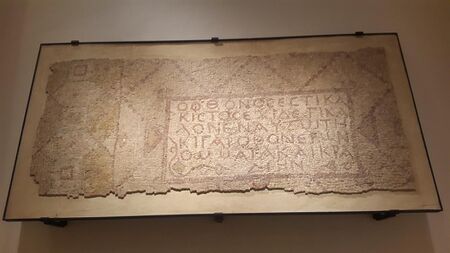Byzantine Mosaics
Topic: Place
 From HandWiki - Reading time: 2 min
From HandWiki - Reading time: 2 min
Byzantine Mosaics are late Roman & Byzantine mosaics of Berytus (actually Beirut, Lebanon). Actually they are often nicknamed the "Beirut's Souk's Byzantine Mosaics".
Overview
During late Roman empire centuries but mostly during Byzantine times, the floors in the area where now there are the 'Souks area' were laid with mosaic pavements. The excavations of the mid-1990s revealed around seven hundred square meters of 4th, 5th and 6th century AD mosaics.
Construction
In Byzantine times, the floors of shops and houses in the area of the Souks were laid with mosaic pavements. The colonnades had mosaic pavements with Greek (and a few latin) letters marking the address of each shop. Most mosaics displayed geometric patterns, although a few incorporated figurative designs.
History
In Byzantine times, the floors of shops and houses in the area of the Souks were laid with mosaic pavements. The archaeological excavations of 1996 unearthed some seven hundred square meters of mosaics, most of them dating back to the 5th and 6th centuries A.D. They were recovered from five large villas and a colonnaded street with its shops. The colonnades had mosaic pavements with Greek letters marking the address of each shop. Most mosaics displayed geometric patterns, although a few incorporated figurative designs. One panel found in the shop, designated with the letter Epsilon, depicts a roaring lion. The mosaic lay at the entrance of the shop, most likely to provide protection. A mosaic in a house behind the colonnaded street depicted the mythical scene of Leda and the Swan. A panel discovered in another house carried a moral message: “Envy is the worst of all evils; there is only one good in it, it eats at the heart and eyes of the beholder.” Recording, cleaning, lifting and storing the large number of mosaics was carried out with great care. Today the ‘Jealousy Mosaic’ can be viewed in Beirut’s National Museum, while some 250 panels of mosaic fragments are kept in storage.
Timeline
1996: Discovery of 700 sqm of mosaics in the Souks area of Beirut, most dating back to the 5th and 6th centuries A.D. (but a few of the 4th century).
See also
- Leda and the Swan
- Beirut National Museum
- Beirut Souks
- Archaeology
- Mosaic Fragment with Man Leading a Giraffe (Art Institute of Chicago)
Bibliography
- Garreau, Sophie and Curvers, Hans H. (2003) Mosaïques de Berytus : Analyses stylistiques et chronologie, Bulletin d’Archéologie et d’Architecture Libanaises 7: 281-320.
- Sheehan, Peter. Mosaics from BEY 006: an introductory catalogue, Berytus, vol. 43:147-166
 KSF
KSF
